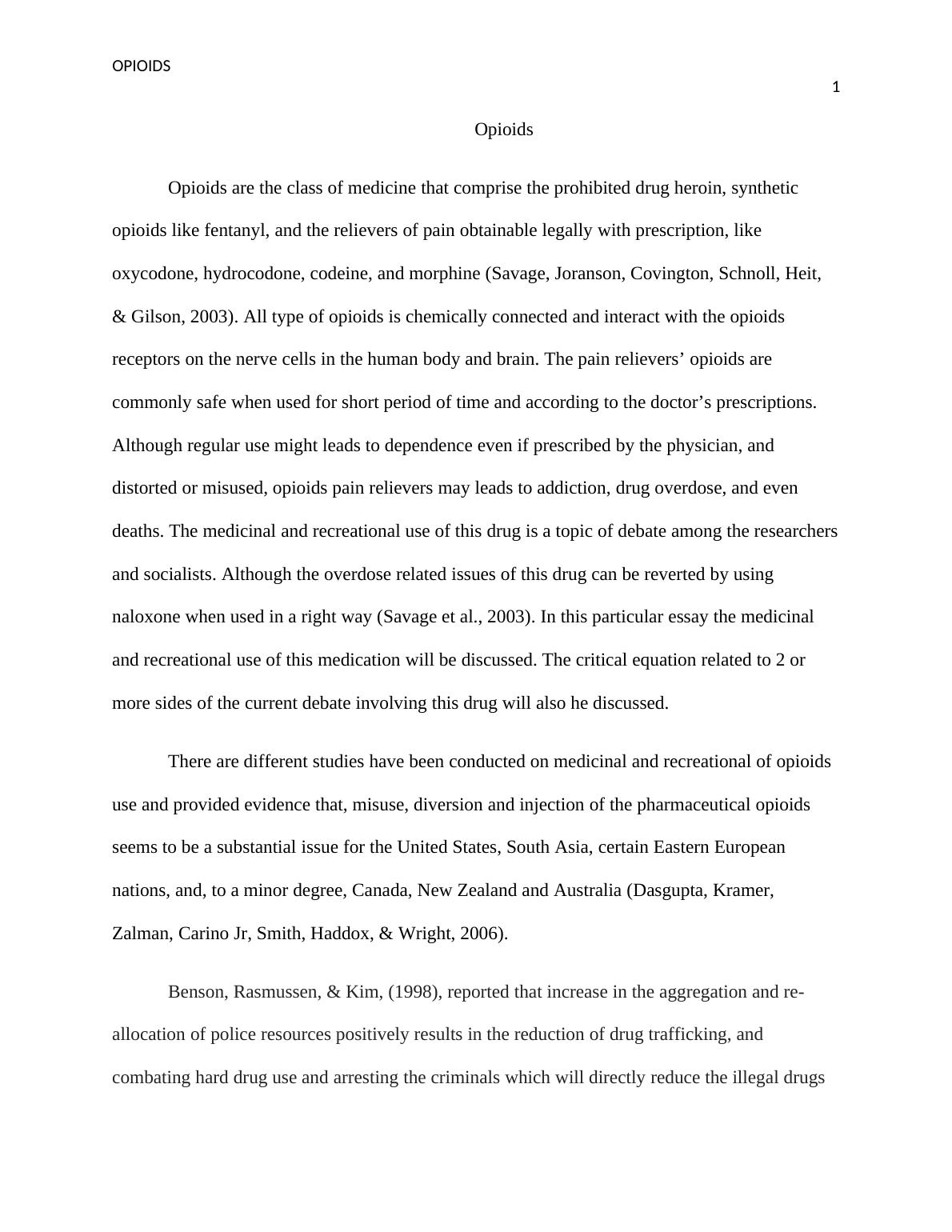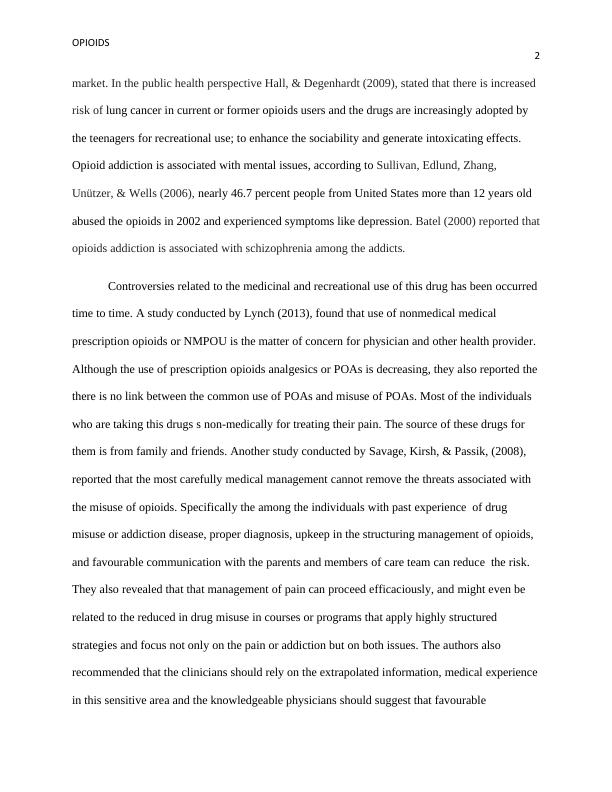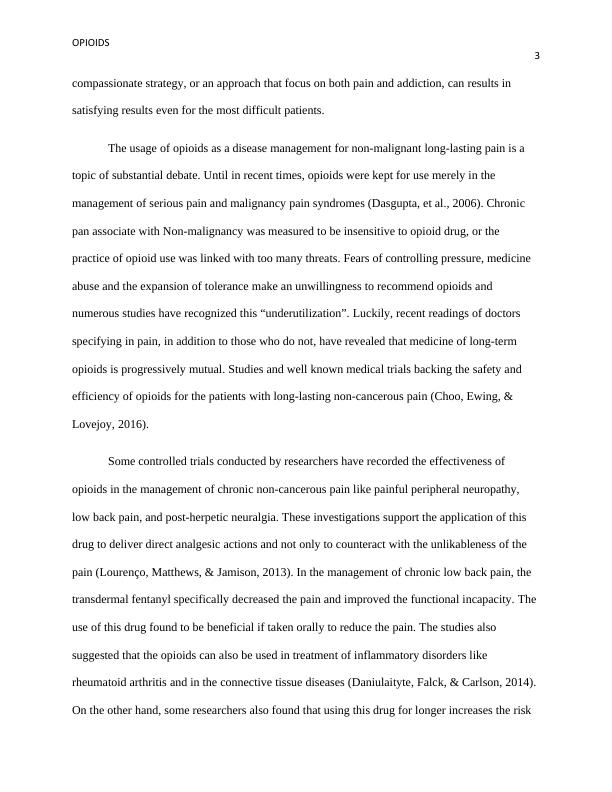Medicinal and Recreational Use of Opioids
Added on 2023-01-16
11 Pages2981 Words221 Views
Running Head: OPIOIDS
0
Opioids
Essay
student
4/1/2019
0
Opioids
Essay
student
4/1/2019

OPIOIDS
1
Opioids
Opioids are the class of medicine that comprise the prohibited drug heroin, synthetic
opioids like fentanyl, and the relievers of pain obtainable legally with prescription, like
oxycodone, hydrocodone, codeine, and morphine (Savage, Joranson, Covington, Schnoll, Heit,
& Gilson, 2003). All type of opioids is chemically connected and interact with the opioids
receptors on the nerve cells in the human body and brain. The pain relievers’ opioids are
commonly safe when used for short period of time and according to the doctor’s prescriptions.
Although regular use might leads to dependence even if prescribed by the physician, and
distorted or misused, opioids pain relievers may leads to addiction, drug overdose, and even
deaths. The medicinal and recreational use of this drug is a topic of debate among the researchers
and socialists. Although the overdose related issues of this drug can be reverted by using
naloxone when used in a right way (Savage et al., 2003). In this particular essay the medicinal
and recreational use of this medication will be discussed. The critical equation related to 2 or
more sides of the current debate involving this drug will also he discussed.
There are different studies have been conducted on medicinal and recreational of opioids
use and provided evidence that, misuse, diversion and injection of the pharmaceutical opioids
seems to be a substantial issue for the United States, South Asia, certain Eastern European
nations, and, to a minor degree, Canada, New Zealand and Australia (Dasgupta, Kramer,
Zalman, Carino Jr, Smith, Haddox, & Wright, 2006).
Benson, Rasmussen, & Kim, (1998), reported that increase in the aggregation and re-
allocation of police resources positively results in the reduction of drug trafficking, and
combating hard drug use and arresting the criminals which will directly reduce the illegal drugs
1
Opioids
Opioids are the class of medicine that comprise the prohibited drug heroin, synthetic
opioids like fentanyl, and the relievers of pain obtainable legally with prescription, like
oxycodone, hydrocodone, codeine, and morphine (Savage, Joranson, Covington, Schnoll, Heit,
& Gilson, 2003). All type of opioids is chemically connected and interact with the opioids
receptors on the nerve cells in the human body and brain. The pain relievers’ opioids are
commonly safe when used for short period of time and according to the doctor’s prescriptions.
Although regular use might leads to dependence even if prescribed by the physician, and
distorted or misused, opioids pain relievers may leads to addiction, drug overdose, and even
deaths. The medicinal and recreational use of this drug is a topic of debate among the researchers
and socialists. Although the overdose related issues of this drug can be reverted by using
naloxone when used in a right way (Savage et al., 2003). In this particular essay the medicinal
and recreational use of this medication will be discussed. The critical equation related to 2 or
more sides of the current debate involving this drug will also he discussed.
There are different studies have been conducted on medicinal and recreational of opioids
use and provided evidence that, misuse, diversion and injection of the pharmaceutical opioids
seems to be a substantial issue for the United States, South Asia, certain Eastern European
nations, and, to a minor degree, Canada, New Zealand and Australia (Dasgupta, Kramer,
Zalman, Carino Jr, Smith, Haddox, & Wright, 2006).
Benson, Rasmussen, & Kim, (1998), reported that increase in the aggregation and re-
allocation of police resources positively results in the reduction of drug trafficking, and
combating hard drug use and arresting the criminals which will directly reduce the illegal drugs

OPIOIDS
2
market. In the public health perspective Hall, & Degenhardt (2009), stated that there is increased
risk of lung cancer in current or former opioids users and the drugs are increasingly adopted by
the teenagers for recreational use; to enhance the sociability and generate intoxicating effects.
Opioid addiction is associated with mental issues, according to Sullivan, Edlund, Zhang,
Unützer, & Wells (2006), nearly 46.7 percent people from United States more than 12 years old
abused the opioids in 2002 and experienced symptoms like depression. Batel (2000) reported that
opioids addiction is associated with schizophrenia among the addicts.
Controversies related to the medicinal and recreational use of this drug has been occurred
time to time. A study conducted by Lynch (2013), found that use of nonmedical medical
prescription opioids or NMPOU is the matter of concern for physician and other health provider.
Although the use of prescription opioids analgesics or POAs is decreasing, they also reported the
there is no link between the common use of POAs and misuse of POAs. Most of the individuals
who are taking this drugs s non-medically for treating their pain. The source of these drugs for
them is from family and friends. Another study conducted by Savage, Kirsh, & Passik, (2008),
reported that the most carefully medical management cannot remove the threats associated with
the misuse of opioids. Specifically the among the individuals with past experience of drug
misuse or addiction disease, proper diagnosis, upkeep in the structuring management of opioids,
and favourable communication with the parents and members of care team can reduce the risk.
They also revealed that that management of pain can proceed efficaciously, and might even be
related to the reduced in drug misuse in courses or programs that apply highly structured
strategies and focus not only on the pain or addiction but on both issues. The authors also
recommended that the clinicians should rely on the extrapolated information, medical experience
in this sensitive area and the knowledgeable physicians should suggest that favourable
2
market. In the public health perspective Hall, & Degenhardt (2009), stated that there is increased
risk of lung cancer in current or former opioids users and the drugs are increasingly adopted by
the teenagers for recreational use; to enhance the sociability and generate intoxicating effects.
Opioid addiction is associated with mental issues, according to Sullivan, Edlund, Zhang,
Unützer, & Wells (2006), nearly 46.7 percent people from United States more than 12 years old
abused the opioids in 2002 and experienced symptoms like depression. Batel (2000) reported that
opioids addiction is associated with schizophrenia among the addicts.
Controversies related to the medicinal and recreational use of this drug has been occurred
time to time. A study conducted by Lynch (2013), found that use of nonmedical medical
prescription opioids or NMPOU is the matter of concern for physician and other health provider.
Although the use of prescription opioids analgesics or POAs is decreasing, they also reported the
there is no link between the common use of POAs and misuse of POAs. Most of the individuals
who are taking this drugs s non-medically for treating their pain. The source of these drugs for
them is from family and friends. Another study conducted by Savage, Kirsh, & Passik, (2008),
reported that the most carefully medical management cannot remove the threats associated with
the misuse of opioids. Specifically the among the individuals with past experience of drug
misuse or addiction disease, proper diagnosis, upkeep in the structuring management of opioids,
and favourable communication with the parents and members of care team can reduce the risk.
They also revealed that that management of pain can proceed efficaciously, and might even be
related to the reduced in drug misuse in courses or programs that apply highly structured
strategies and focus not only on the pain or addiction but on both issues. The authors also
recommended that the clinicians should rely on the extrapolated information, medical experience
in this sensitive area and the knowledgeable physicians should suggest that favourable

OPIOIDS
3
compassionate strategy, or an approach that focus on both pain and addiction, can results in
satisfying results even for the most difficult patients.
The usage of opioids as a disease management for non-malignant long-lasting pain is a
topic of substantial debate. Until in recent times, opioids were kept for use merely in the
management of serious pain and malignancy pain syndromes (Dasgupta, et al., 2006). Chronic
pan associate with Non-malignancy was measured to be insensitive to opioid drug, or the
practice of opioid use was linked with too many threats. Fears of controlling pressure, medicine
abuse and the expansion of tolerance make an unwillingness to recommend opioids and
numerous studies have recognized this “underutilization”. Luckily, recent readings of doctors
specifying in pain, in addition to those who do not, have revealed that medicine of long-term
opioids is progressively mutual. Studies and well known medical trials backing the safety and
efficiency of opioids for the patients with long-lasting non-cancerous pain (Choo, Ewing, &
Lovejoy, 2016).
Some controlled trials conducted by researchers have recorded the effectiveness of
opioids in the management of chronic non-cancerous pain like painful peripheral neuropathy,
low back pain, and post-herpetic neuralgia. These investigations support the application of this
drug to deliver direct analgesic actions and not only to counteract with the unlikableness of the
pain (Lourenço, Matthews, & Jamison, 2013). In the management of chronic low back pain, the
transdermal fentanyl specifically decreased the pain and improved the functional incapacity. The
use of this drug found to be beneficial if taken orally to reduce the pain. The studies also
suggested that the opioids can also be used in treatment of inflammatory disorders like
rheumatoid arthritis and in the connective tissue diseases (Daniulaityte, Falck, & Carlson, 2014).
On the other hand, some researchers also found that using this drug for longer increases the risk
3
compassionate strategy, or an approach that focus on both pain and addiction, can results in
satisfying results even for the most difficult patients.
The usage of opioids as a disease management for non-malignant long-lasting pain is a
topic of substantial debate. Until in recent times, opioids were kept for use merely in the
management of serious pain and malignancy pain syndromes (Dasgupta, et al., 2006). Chronic
pan associate with Non-malignancy was measured to be insensitive to opioid drug, or the
practice of opioid use was linked with too many threats. Fears of controlling pressure, medicine
abuse and the expansion of tolerance make an unwillingness to recommend opioids and
numerous studies have recognized this “underutilization”. Luckily, recent readings of doctors
specifying in pain, in addition to those who do not, have revealed that medicine of long-term
opioids is progressively mutual. Studies and well known medical trials backing the safety and
efficiency of opioids for the patients with long-lasting non-cancerous pain (Choo, Ewing, &
Lovejoy, 2016).
Some controlled trials conducted by researchers have recorded the effectiveness of
opioids in the management of chronic non-cancerous pain like painful peripheral neuropathy,
low back pain, and post-herpetic neuralgia. These investigations support the application of this
drug to deliver direct analgesic actions and not only to counteract with the unlikableness of the
pain (Lourenço, Matthews, & Jamison, 2013). In the management of chronic low back pain, the
transdermal fentanyl specifically decreased the pain and improved the functional incapacity. The
use of this drug found to be beneficial if taken orally to reduce the pain. The studies also
suggested that the opioids can also be used in treatment of inflammatory disorders like
rheumatoid arthritis and in the connective tissue diseases (Daniulaityte, Falck, & Carlson, 2014).
On the other hand, some researchers also found that using this drug for longer increases the risk

End of preview
Want to access all the pages? Upload your documents or become a member.
Related Documents
The New Drug Abuse Crisislg...
|4
|758
|421
Opioid Abuse in Healthcare in USlg...
|14
|3055
|7
Opioid Addiction And Abuse Epidemiclg...
|16
|4873
|14
The History of Prescription Drug Abuse Changelg...
|7
|1984
|96
HEALTH CARE POLICY.lg...
|3
|469
|46
Literature Review on Opioid Addiction Crisislg...
|9
|1880
|220
